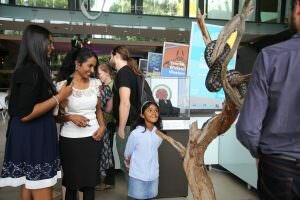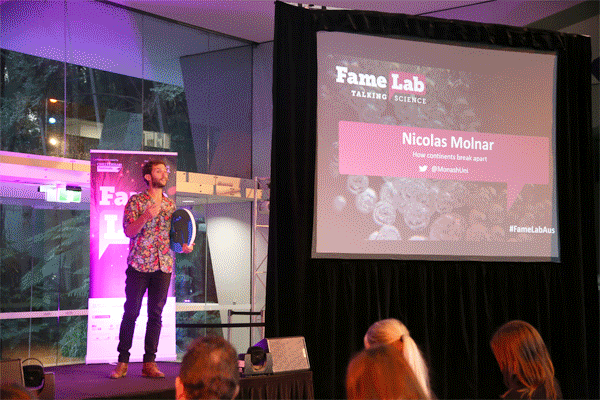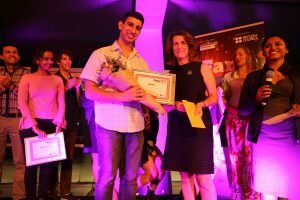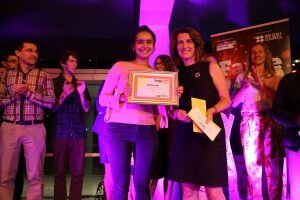Last updated May 30, 2017 at 12:31 pm
12 of the country’s top science communicators got their 3 minutes of fame at the FameLab Victoria semi-final on 30 March 2017. This fully-booked event was the second state semi-final for 2017 at the Melbourne Museum.
 The audience were treated to Melbourne Museum live exhibits before they enjoyed a night of entertaining science communication.
The audience were treated to Melbourne Museum live exhibits before they enjoyed a night of entertaining science communication.
In the first half of the evening, the audience heard about everything from scale models of continents breaking apart to using big ass lasers to study DNA, and giving iPads to mice to understand Alzheimer’s disease.
The second half featured highlights such as super fast internet with visible light communications, to getting rich and finding gold in ‘rock sweat’, to designer maggots, stressful mothers and pee-phora, the wonderful feeling you get from relieving yourself!
Tectonic plates, zebra finches & using snail shells as climate change predictors – just some of the talks we’ve heard at #FameLabAus so far!
— British Council (@auBritish) March 30, 2017
The FameLab Australia competition is coordinated by the British Council in Australia.
Molecular biologist and science communicator Upulie Divisekera was the presenter for the Victoria state semi-final.
The judges –
- David Farmer, neuroscientist at Florey institute in Melbourne, 2015 FameLab national finalist
- Helen O’Neil, director of the British Council in Australia
- Linda Sproul, manager of education and community programs at Museum Victoria
In order of presentation (and shown below), the VIC state finalists were:
- Nicolas Molnar, Monash University: ‘How continents break apart’
- Andrew Katsis, Deakin University: ‘The benefits of being an attentive embryo’
- Vini Gautam, Australian National University: ‘Rewiring the brain’
- Georgy Falster, University of Adelaide: ‘Leaving a trail’
- Daniel Langley, La Trobe University: ‘Removing the bottle neck from determining the building blocks of life’
- Amy Shepherd, Florey Institute of Neuroscience and Mental Health: ‘How iPads for mice can help us find a treatment for Alzheimer’s’
- Abdullah Saed, University of South Australia: ‘Visible Light Communications’
- Chris Voisey, Monash University: ‘Earthquake gold, where and how’
- Shaz Sivanesan, Monash University: ‘Recalibrating the magic bullet – Polymyxins’
- Natalie Gasz, Deakin University: ‘Maggots: friend or foe?’
- Amy Edwards, La Trobe University: ‘How controlling is your mum?’
- Brooke Huuskes, Monash University: ‘You, me and pee’

After fascinating presentations, the winners were announced:
- WINNER: Andrew Katsis from Deakin University,
- RUNNER-UP: Vini Gautam from Australian National University, and
- AUDIENCE CHOICE: Brooke Huuskes from Monash University
CONGRATS to the winners of #FameLabAus last night: @andrew_katsis (@Deakin) @GautamVini (@ANUmedia) @BrookeHuuskes (@Monash_FMNHS) #scicomm pic.twitter.com/P3C1fQbYqw
— British Council (@auBritish) March 30, 2017
Helen O’Neil, Director of the British Council in Australia, says, “The semi-final in Melbourne was a fantastic evening that provided an enlightening insight into some of the great research coming out of labs across Australia. We heard 12 engaging and inspiring stories of science from some of the country’s brightest minds, but it was Andrew who stood out to the judges on the three key criteria of content, clarity and charisma.”
Congratulations to Andrew and Vini who will be going onto the national final in Fremantle on 4 May 2017.


Event details for the other state semi-finals here. It’s free to attend and to enjoy a night of great science communication!
We are proud to be a media partner with the British Council in Australia to this event.






























































































































































































































































































































































































































































































